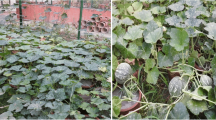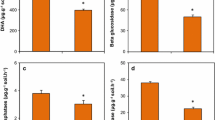Abstract
The present study focuses on the possibility of applying fly ash to agricultural fields for enhancing the production of agricultural crops. In this study, Pisum sativum L. was grown from germination stage to maturation stage in phytoremediated and non-phytoremediated or raw fly ash-amended soil. All the morphological (height, biomass, number of leaf, and leaf size) and physiological parameters like, protein content, chlorophyll content, nitrate reductase activity, and peroxidase activity were monitored to understand the effects of fly ash or its usefulness for using it as a fertilizer for facilitating micronutrients. Major finding of this study is that 40% (w/w) of non-phytoremediated fly ash amendment could be used for field application. Percentage increase of toxic metals in below ground organs was 6% for Cd, 6% for Cr, 5% for Cu, 15% for Mn, and 7% for Pb when compared with the control. In the non-phytoremediated fly ash-amended set, heavy metals and metalloids were present in the grains only at higher amendments T3 (60%) and T4 (80%). However, except Cd, all the metals were below the permissible limits suggested by the WHO. Phytoremediated fly ash could be used as a fertilizer up to 100% for the cultivation of pea plant as metals concentrations were found either below detection limit or below the WHO permissible limit.




Similar content being viewed by others
Data availability
The authors confirm that the data supporting the findings of this study are available within the article.
References
Ahmaruzzaman M (2010) A review on the utilization of Fly ash. Prog Energy Combust Sci 36:327–363
Akineinde EA, Adigun IO (2005) Phosphorus use efficiency by pepper (Capsicum frutescens) and okra (Abelmoschus esculentus) at different phosphorus fertilizer application levels on two tempearte soils. J Appl Sci 5:1785–1791
Arnon DI (1949) Copper enzymes in isolated chloroplasts polyphenol oxidase in Beta vulgaris. Plant Physiol 24:1–15
Bahadur A, Manohar RK (2001) Response of okra to biofertilizers. Vegetable Science 28:197–198
Bahadur V, Singh T (1990) Yield and growth response of garden pea (Pisum sativum) to nitrogen and phosphorus application. Vegetable Science 17:205–209
Bhattacharya T, Chakaraborty S, Banerjee DK (2010) Heavy metal uptake and its effect on Macronutrients, chlorophyll, protein, and peroxidase activity of Paspalum distichum grown on sludge-dosed soils: Heavy metal uptake and its effect on P. distichum. Environ Monit Assess 169:15–26
Bigdeli M, Seilsepour M (2008) Investigation of Metals Accumulation in Some Vegetables Irrigated with Waste Water in Shahre Rey-Iran and Toxicological Implications. American-Eurasian J Agric Environ Sci 4(1):86–92
Borah M (2012) Effect of Heavy metals and metalloidsand metalloidson Pisum sativum L.Linn. Int J Adv Biotechnol Res 2:314–321
Bose S, Chandrayan S, Rai V, Bhattacharyya AK, Ramanathan AL (2008) Translocation of metals in pea plants grown on various amendment of electroplating industrial sludge. Bioresour Technol 99:4467–4475
Bradford MM (1976) A rapid and sensitive method for the quantification of microgram quantities of protein utilizing the principle of protein dye binding. Anal Biochem 72:248–259
Chaplygin VA, Minkina TM, Mandzhieva SS, Nazarenko OG, Zimulina IV, Bauer TV, Litvinov Yu A, Rajput V (2021) Heavy metals in agricultural crops of Rostov region through the example of soft wheat (Triticum aestivum). IOP Conf Ser: Earth Environ Sci 624:012204. https://doi.org/10.1088/1755-1315/624/1/012204
Codex Alimentarius Commission (FAO/WHO) Food additives and contaminants. Joint FAO/WHO Food Standards Program 2001, ALINORM 01/12A, 1-289.
Datta SP, Bishwas DR, Saharan N, Ghosh SK, Rattan RK (2000) Effect of long term application of sewage effluents on organic carbon, potassium, and heavy metal status of soils and content of heavy metals and metalloidsand metalloidsin crops. J Indian Soc Soil Sci 48:836–839
Diez T, Krauss M (1997) Wirkung langjähriger Kompostdüngung auf Pflanzenertrag und Bodenfruchtbarkeit. Effect of longterm compost application on yield and soil fertility. Agrobiol Res 50:78–84
Gupta PK (2000) Methods in Environmental Analysis - Water, Soil and Air. Agrobios, Jodhpur, India.
Gupta M, Cuypers A, Vangronsveld J, Clijsters H (1999) Copper affects the enzymes of the ascorbate-glutathione cycle and its related metabolites in the roots of Phaseolus vulgaris. Physiol Plant 106:262–267
Gupta AK, Dwivedi S, Sinha S, Tripathi RD, Rai UN, Singh SN (2007) Metal accumulation and growth performance of Phaseolus vulgaris grown in fly-ash amended soil. Bioresour Technol 98:3404–3407
Kalra N, Joshi HC, Chaudhary A, Choudhary R, Sharma SK (1997) Impact of flyash incorporation in soil on germination of crops. Bioresour Technol 61:39–41
Klepper L, Flesher D, Hageman RH (1971) Generation of reduced nicotinamide adenine dinucleotide for nitrate reduction in green leaves. Plant Physiol 48:580–590
Kumar A, Bhattacharya T (2020) Biochar: a sustainable solution. Environ Dev Sustain 23:6642–6680. https://doi.org/10.1007/s10668-020-00970-0
Kumar A, Bhattacharya T (2021) Removal of Arsenic by Wheat Straw Biochar from Soil. Bull Environ Contam Toxicol. https://doi.org/10.1007/s00128-020-03095-2
Kumar A, Bhattacharya T, Mozammil Hasnain SM, Kumar NA, Hasnain S (2020) Applications of biomass-derived materials for energy production, conversion, and storage. Mater Sci Energy Technol 3:905–920
Lagrimini LM (1991) Wound-induced deposition of polyphenols in transgenic plants overexpressing peroxidase. Plant Physiol 96:577–583
Lau SSS, Wong JWC (2001) Toxicity evaluation of weathered coal Fly ash amended manure compost. Water Air Soil Pollut 128:243–254
Lee H, Ha HS, Lee CS, Lee YB, Kim PJ (2006) Fly ash effect on improving soil properties and rice productivity in Korean paddy soil. Bioresour Technol 97:1490–1497
Maiti SK, Jaiswal S (2008) Bioaccumulation and translocation of metals in the natural vegetation growing on Fly ash lagoons: a field study from Santaldih thermal power plant, West Bengal, India. Environ Monit Assess 136:355–370
Olsen SR, Cole CV, Watanabe FS, Dean LA (1954) Estimation of available phosphorus in soils by extraction with sodium bicarbonate. United States Department of Agriculture Circular 19, Washington DC, 939.
Pandey VC (2015) Assisted phytoremediation of fly ash dumps through naturally colonized plants. Ecol Eng 82:1–5. https://doi.org/10.1016/j.ecoleng.2015.04.002
Pandey VC (2020a) Scope of Fly ash use in agriculture–prospects and challenges. In: Phytomanagement of Fly ash. Elsevier, Amsterdam, pp 63–101. https://doi.org/10.1016/B978-0-12-818544-5.00003-1
Pandey VC (2020b) Fly ash properties, multiple uses, threats, and management: an introduction. In: Phytomanagement of Fly ash. Elsevier, Amsterdam, pp 1–34. https://doi.org/10.1016/B978-0-12-818544-5.00001-8
Pandey VC (2020c) Opportunities and challenges in Fly ash –aided paddy agriculture. In: Phytomanagement of Fly ash. Elsevier, Amsterdam, pp 103–139. https://doi.org/10.1016/B978-0-12-818544-5.00004-3
Pandey VC (2021) Direct seeding offers affordable restoration for fly ash deposits. Energy, Ecology and Environment. https://doi.org/10.1007/s40974-021-00212-7
Pandey SK, Bhattacharya T (2018) Effects of two biodegradable chelates on metals uptake, translocation and biochemical changes in Lantana camara growing in Fly ash amended soil. International journal of phytoremediation 20:214–224
Pandey SK, Bhattacharya T (2019) Mobility, Ecological risk and change in surface morphology during sequential chemical extraction of heavy metals and metalloidsand metalloidsin Fly ash: A case study. Environ Technol Innov 132:373–382
Pandey VC, Singh N (2010) Impact of Fly ash incorporation in soil systems. Agric Ecosyst Environ 136:16–27
Pandey VC, Abhilash PC, Singh N (2009) The Indian perspective of utilizing Fly ash in phytoremediation, phytomanagement and biomass production. J Environ Manag 90:2943–2958
Pandey VC, Abhilash PC, Upadhyay RN, Tewari DD (2009b) Application of Fly ash on the growth performance, translocation of toxic heavy metals and metalloids within Cajanus cajan L.: implication for safe utilization of Fly ash for agricultural production. J Hazard Mater 166:255–259
Pandey VC, Singh JS, Kumar A, Tewari DD (2010) Accumulation of heavy metals and metalloidsand metalloidsby chickpea grown in Fly ash treated soil: effects on antioxidants. Clean-Soil Air Water 38:1116–1123
Pandey SK, Bhattacharya T, Chakraborty S (2016) Metal Phytoremediation Potential of Naturally Growing Plants on Fly ash Dumpsite of Patratu Thermal Power Station, Jharkhand, India. International Journal of Phytoremediation 18:87–93
Peralta JR, Gardea JL, E-Gomez S, Arteaga E, Rascon JG (2001) Uptake and effect of five HMs on seed germination and plant growth in Alfalfa. Parsen. Bull Environ Contain Toxicol 66:727–734
Rotaru V, Sinclair TR (2009) Interactive influence of phosphorus and iron on nitrogen fixation by soybean. Environ Exp Bot 66:94–99
Singh JS, Pandey VC, Singh DP, Singh RP (2011) Coal Fly ash and farmyard manure amendments in dry-land paddy agriculture field: effect on N– dynamics and paddy productivity. Appl Soil Ecol 47:133–140
United States Environmental Protection Agency (US EPA) (2002) Supplemental guidance for developing soil screening levels for superfund sites. Office of Solid Waste and Emergency Response, Washington, D.C.
Walkley A, Black IA (1934) Estimation of soil organic carbon by chromic acid titration method. Soil Sci 37:29–38
Wong MH, Wong JWC (1989) Germination and seedling growth of vegetable crops in Fly ash -amended soils. Agric Ecosyst Environ 26:23–35
Acknowledgements
The authors are grateful to Central Instrumentation facility of BIT, Mesra, for providing Research facility. The author is also thankful to Jawaharlal Nehru Memorial Fund for providing research fellowship (Ref: SU-1/291/2016-17/83).
Funding
This work was supported by Jawaharlal Nehru Memorial Fund for providing research fellowship (Ref: SU-1/291/2016-17/83).
Author information
Authors and Affiliations
Contributions
TB: conceptualization, supervision, visualization, writing-original draft. SKP: methodology, formal analysis, writing-original draft. SKP & AK: analyzed data and soil analysis. VCP: conceptualization, visualization, writing—review and editing.
Corresponding author
Ethics declarations
Ethics approval
This work was performed in compliance with ethical standards.
Consent to participate
All authors were informed about, and agreed to the protocol.
Consent for publication
All authors were allowed to read and approve the final manuscript.
Conflict of interest
The authors declare no competing interests.
Additional information
Responsible Editor: Elena Maestri
Publisher’s note
Springer Nature remains neutral with regard to jurisdictional claims in published maps and institutional affiliations.
Tanushree Bhattacharya and Shikha Kumari Pandey are joint first author.
Rights and permissions
About this article
Cite this article
Bhattacharya, T., Pandey, S.K., Pandey, V.C. et al. Potential and safe utilization of Fly ash as fertilizer for Pisum sativum L. Grown in phytoremediated and non-phytoremediated amendments. Environ Sci Pollut Res 28, 50153–50166 (2021). https://doi.org/10.1007/s11356-021-14179-9
Received:
Accepted:
Published:
Issue Date:
DOI: https://doi.org/10.1007/s11356-021-14179-9




